Radioactive Cosmetics
The 1898 discovery of radium by Marie and Pierre Curie generated a great deal of scientific interest and, before long, medical and other commercial uses were found for this radioactive material.
[Radium] became involved in the physical system of alpha, beta, and gamma rays and the atomic structure; in the chemical system of atomic weights, emanations, and transmutations; in the medical system of cancer treatments and radon spas; in the commercial system of luminous watches, women’s cosmetics, and medical remedies; in the artistic system of luminous paintings and middle-class American culture; and in the industrial system of radium extractions, the production of luminous paint, and the beauty industry.
(Rentetzi, 2007, p. 1)
Medical and other uses of radium
Medically, radium was usually injected or taken in pills. It was used to treat a wide range of ailments including hair loss, impotence, atherosclerosis, high blood pressure, rheumatism, gout, sciatica, nephritis and anaemia. This led to a craze for radium-based products, and radioactivity in general, during the 1920s and 1930s. It was added to a wide range of commercial products including: wool for babies, water dispensers, chocolate, soda water, male supports, foundation garments, condoms, toothpaste, suppositories, cigarettes, cleaning products, boot polish, fertilisers, luminous paints and cosmetics. All of these commercial applications had a common theme; that the rays given off by radium had a ‘vitalising’ effect on the human body.
Cosmetics
A number of companies put radioactive materials into cosmetics. As the original work on radium was carried out by the French scientists, Marie and Pierre Curie, it is not surprising that this was more common in France than elsewhere. England also had a number of cosmetic companies that used radium but the same cannot be said of the United States.
Radior
From about 1917, the London-based Radior company began marketing a line of cosmetics containing radium, including a Night Cream, Rouge, Compact Powder, Vanishing Cream, Talcum Powder, Hair Tonic, Skin Soap, Face Powder in six tints (Blanche, Naturelle, Rachel, Flesh, Ochre and Brunette) and assorted pads that could be strapped to the face.
An ever-flowing Fountain of Youth and Beauty has at last been found in the Energy Rays of Radium.
When scientists discovered Radium they hardly dreamed they had unearthed a revolutionary “Beauty Secret.” They know it now. Radium Rays vitalize and energize all living tissue. This Energy has been turned into Beauty’s aid. Each and every ‘Radior’ Toilet Requisite contains a definite quantity of Actual Radium.(Radior advertisement, 1918)
The product sold well in Britain, possibly due to the fact that it was distributed by Boots “in all their five hundred and eighty-five stores” (Foster, 1920, p. 29) as well as Harrods, Selfridges, Whiteley’s, Marshall & Snelgroves and other outlets. It was also available in selected stores in some parts of the British Empire.
“Radior” Chin straps are guaranteed to contain Radio-active substance and Radium Bromide. If placed on the face where the skin has become wrinkled or tired the radio-active forces immediately take effect on the nerves and tissues. A continuous steady current of energy flows into the skin, and before long the wrinkles have disappeared, the nerves have become strong and energised, and the tired muscles have become braced up and “ready for service.”
(Radior advertisement, 1915)
The product did less well in America when introduced there. In an interview, a company spokesperson noted that market research put the cause for poor sales on the reduced use of radium in U.S. medicine and public disbelief that such an expensive material could be used in cosmetic pads. The spokesperson explained that it was “possible to divide and subdivide radium until you can get as small an amount as one sixty-fourth of a cent’s worth. It seems incredible, I know, but chemists are used to these infinitesimal divisions. The radium would still be genuine and would retain all its valuable properties. For this reason and because of its enormous strength we are able to use it in these pads and still sell them at a profit.” (Foster, 1920, p. 29). Radior countered the misconception with a guarantee that radium was present in every product. Fortunately, sales of Radior remained low in the United States and those individuals that did use the products were exposed to very low levels of radiation.
Tho-Radia
In 1933, a pharmacist, Alexis Moussali and a Parisian doctor, Alfred Curie, launched a French range of radioactive beauty products, first from the Rue des Capucines and then from 146 Avenue Victor Hugo. Alexis Moussali was probably the brains behind the commercial operation, with Dr. Alfred Curie – if he actually existed – brought along because of his surname – Marie and Pierre Curie had no relation of that name.
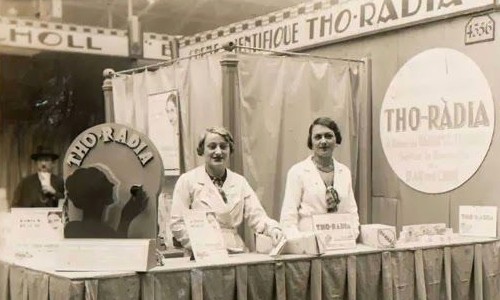
Tho-Radia display at a trade show.
The product range, which included a cleansing milk, skin cream, powder, rouge, lipstick and toothpaste, was called Tho-Radia as it contained thorium chloride and radium bromide, both of which are radioactive. The products were relatively expensive for the time, possibly due, in part, to the cost of the radioactive materials. As with Radior, one hopes that the expense of the ‘active ingredients’ may have resulted in reduced amounts of thorium and radium being incorporated into the cosmetics.
The Tho-Radia cream was sold for 15 francs per 155 gram pot; soap, 3 francs per 100 gram bar; powder, 12 francs per 50 gram box; toothpaste, 6 francs per tube. Despite the relatively high price, it sold throughout France from 1933 through to the early 1960s but I have not found any evidence that they had a distributor in the English-speaking world. When tested in the 1960s, the products were still found to be radioactive (Mould, n.d. p. 3).
Like other products of the time, Tho-Radia was advertised as being a scientific method of beauty (Méthod Scientific de Beauté). The medical ‘benefits’ of radium had been highly publicised in the French press and were well known by the French populace in the 1930s. Product advertising shows a face lit from below which makes it look like it is ‘glowing’. What could be healthier than a glowing complexion?
An associated booklet produced by the company makes the following claims:
Elle stimule la vitalité cellulaire active la circulation, élimine la graisse, empêche la déformation des pores, previent et guérit dartres, boutons, rougeurs, défend la peau contre les miasmas et les intempéries, combat toutes les altérations de l’épipiderme, evite at supprime les rides, conserve la fraîcheur et l’éclat du teint.
Translation:
Stimulates cellular vitality, activates circulation, firms skin, eliminates fats, stops enlarged pores forming, stops and cures boils, pimples, redness, pigmentation, protects from the elements, stops ageing and gets rid of wrinkles, conserves the freshness and brightness of the complexion.(Dictionnaire soins de beauté. p. 37)
Artes
In 1933, a new radium rejuvenating cream was launched on the British cosmetic market. Made in London, using imported radium, it was claimed that it “assists blood circulation and generally tones up the skin.” Rather than containing radium salts the cream was made using radium gas.
The use of radium itself would, of course, be impossible on account of the tremendous cost and harmful effect on the skin. Radon, however, which is the gas obtained from radium, impregnated into the cream, is the constituent which gives the cream its value.
There can be no danger of ill-effects through accumulation because radon is completely eliminated from the skin within a period of six hours. We understand that this form of treatment has the approval of the medical and scientific authorities both in England and on the continent.(Hairdresser and Beauty Trade, 1933)
Kemolite and other mud treatments
The 1920s saw the widespread use of complexion clays both in salons and in home treatments. One variation on this trend was to use radioactive mud, the most common form being Kemolite Radio-Active Beauty Plasma, advertised as a volcanic mud from the Carpathian mountains.
Wrinkles and Lines.—When applied DAILY over these creasings of the skin “Kemolite” will restore smoothness and freedom from Lines and Wrinkles.
Sagging Muscles and Lost Facial Contour.—“Kemolite” tones up relaxed muscles, tissues and nerves.
Acne or Blackheads, Blotches, Rashes, Redness, and roughness.—“Kemolite” proves a wonderful corrective of these conditions when used regularly.
Freckles and Sunburn.—There is nothing better than “Kemolite,” as a fair trial will demonstrate.
Sallowness, Oily, Shiny, or Damp Skin.—“Kemolite” improves the action of the pores and of the capillary blood vessels, and restores the skin and its complexion to their normal condition and colouring.(Kemolite advertisement, 1922)
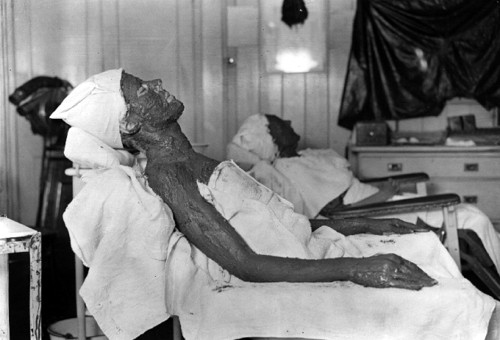
1922 Two women having Kemolite mud treatment.
1922 A woman having a Kemolite facial.
See also: Complexion Clays and the A.M.A.
A beauty salon could also provide clients with a radioactive mudpack by mixing a small amount of radioactive material in with a normal complexion clay.
To provide a mud pack which is really radio-active it is necessary to add to it one microcurie of Radium Salts. This is a very small quantity but even this produces wonderful results, especially for skin troubles such as sallowness, blackheads, etc.
The chief thing therefore is to be sure that the mud pack you use is a genuine radio-active pack. It may be a little more expensive for you to use, but by explaining to your client what you are using on her, and being able to show her an immediate improvement in her appearance, you will be able to charge a little more for this treatment.
Care should be taken to thoroughly cleanse the skin before applying the mud pack. I am afraid there is still a little indifference in this respect on the part of some operators, in fact I know it is common practice to cleanse the face with ordinary cold cream or massage cream. This is not sufficient, and to prove it try cleansing the face with cold cream, wipe all traces away and immediately apply liquefying cleansing cream. You need not rub it in, just smooth over the face, leave on for a minute and then wipe off with a fresh tissue. You will see that the liquefying cream has absorbed into the pores and with a friction action has raised the stale powder, etc., to the surface.
The mud should be mixed with warm water to the consistency of clotted cream and applied evenly over the parts to be treated. Leave the pack on for twenty or thirty minutes to do its work. If at the end of this time it is not dry it makes no difference; do not use a lamp or hand dryer to dry it. Remove the mud and wash the skin with lukewarm water gently but firmly. To be rough with the skin after a mud pack will cause tenderness, especially in winter. …
See that the client is warm while the mud pack is drying, otherwise it is apt to be an unpleasant experience. If this treatment is being given for general toning up a weekly pack will be found sufficient, but for bad cases of blackheads and other skin troubles it is advisable to give a course of treatment. The first week two or three mud packs should be given; after that according to the response, always remembering that frequency and regularity will produce results. Hands that have become prematurely aged will benefit by this treatment.(Hairdresser and beauty trade, 1937, p. 9)
Hindsight is a wonderful thing
The use of radioactive materials in cosmetics is a good example of what can go wrong when the beauty industry jumps too quickly on the bandwagon of a scientific advance. Despite this, and other ingredients that would also prove detrimental to health, the role of science in the beauty industry increased, not diminished, during the century. Even today, when so many are demanding more ‘natural’ products we still look to science to ensure their purity and safety.
Fist Posted: 14th April 2009
Last Update: 6th September 2021
Sources
Tho-Radia. Dictionnaire médical et pratique des soins de beauté. Paris: Author.
Foster, O. D. (1920). Overcoming high resistance in marketing. Advertising & Selling. June 26, 29-30.
Hairdresser and beauty trade. (1933). 41, 2. London.
Madame Claire. (1937). The application of mud packs. Hairdresser and Beauty Trade. X(11). 9.
Mould, D. Radiation history anecdotes. No 2: The mysterious Dr Alfred Curie.
Rentetzi, M. (2007). Trafficking Materials and Gendered Experimental Practices. New York: Columbia University Press.
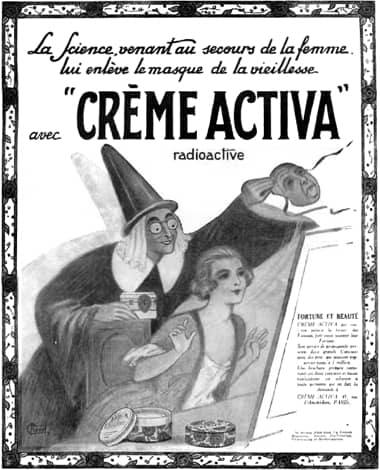
1917 Crème Activa (France).
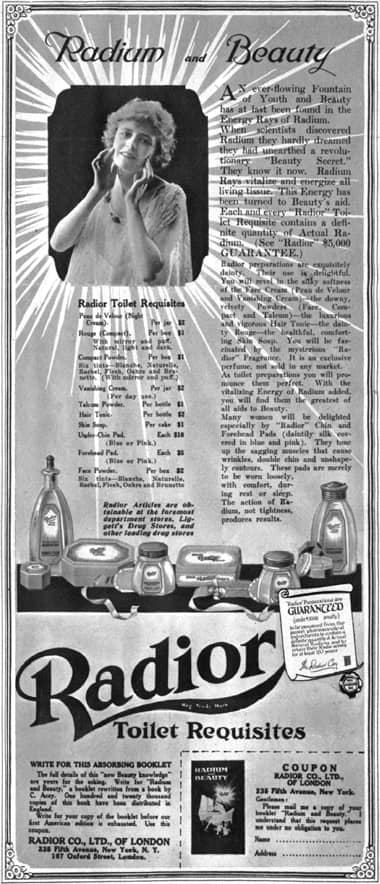
1918 Radior Toilet Requisites (America).
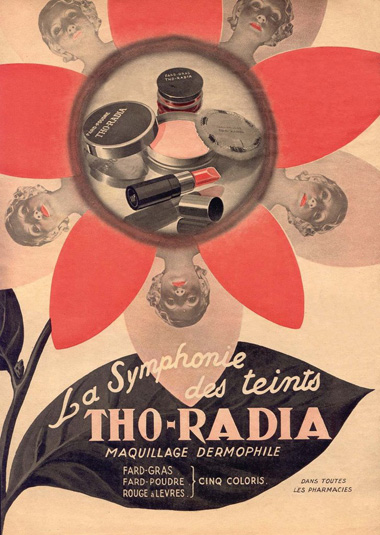
Tho-Radia: A symphony of shades (France).
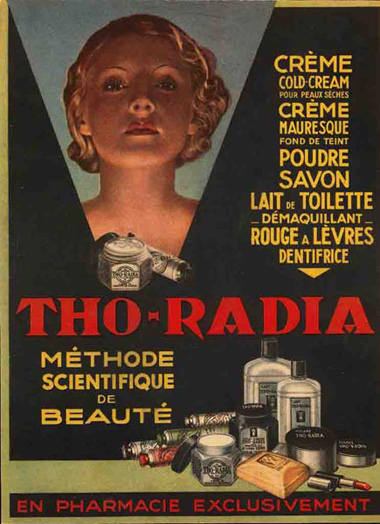
Tho-Radia Cream, Cold cream for dry skin, Arabian cream foundation, Powder, Soap, Toilet milk, Makeup remover, Lipstick, Toothpaste.
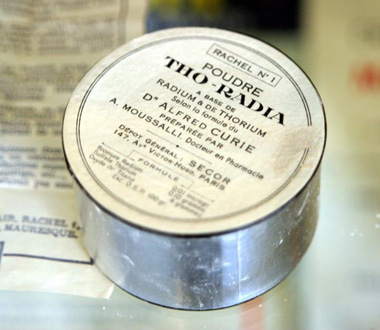
Tho-Radia powder containing radium and thorium.
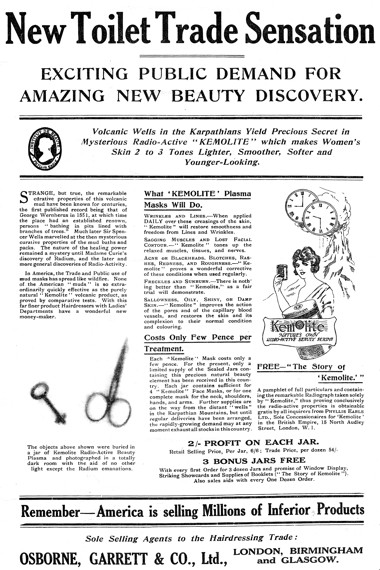
1922 Kemolite. “Volcanic Wells in the Karpathians Yield Precious Secret in Mysterious ‘Kemolite’ which makes Women’s Skin 2 to 3 Tones Lighter, Smoother, Softer and Younger-Looking” (Britain).
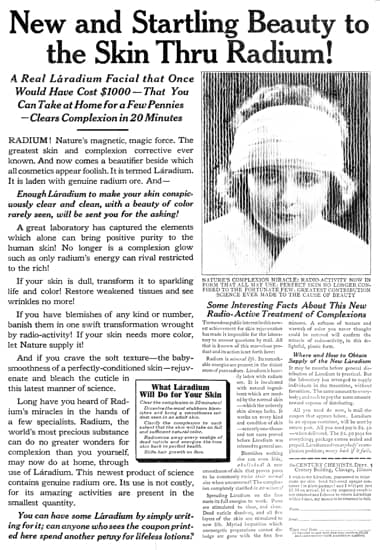
1923 Láradium from Century Chemists, the same firm that sold English Complexion Clay (Ryerson’s Forty Minute Beauty Clay).
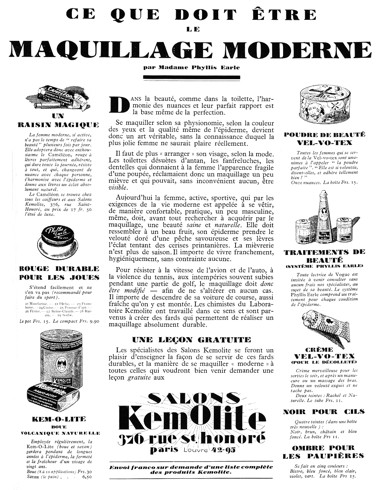
1927 Madame Phyllis Earle. The rights for Kemolite in Europe and the British Empire were owned by Phyllis Earle; she included it in her salon treatments and also added it to a soap.

1928 Helene Pessl Mud-Radio (Vienna).

1932 Radoir (Britain).

1932 Artes Radium Cream (Britain).

Crème Ramey. “Radium regenerates the epidermis”.

1944 Caria Radium (France).
